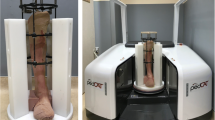Abstract
Background
Subtle Lisfranc joint injuries remain challenging to diagnose. Although of questionable accuracy, the current gold standard to assess these injuries is through bilateral weight-bearing radiography. However, weight-bearing cone beam–computed tomography (CBCT), providing clearer visualization of bony landmarks, can also be utilized for evaluation. This study aims to establish the hypothesis that a specific weight-bearing CBCT finding (asymmetric lambda sign) can serve as an independent indicator of a subtle Lisfranc injury.
Methods
Weight-bearing CBCT images of 24 match-paired cadaveric legs were acquired, initially intact, and then following sequential dissection of each aspect (dorsal, interosseous, and plantar ligaments, respectively) of the Lisfranc ligamentous complex (LLC). All scans were taken in non- (NWB, 0 kg), partial- (PWB, 40 kg), and full-weight-bearing (FWB, 80 kg) manners. The lambda sign was then inspected axially for asymmetry (positive sign) by identifying three symmetrical joint spaces created between the medial cuneiform and the second metatarsal base (C1-M2), the medial and middle cuneiform (C1-C2), and the second metatarsal base and middle cuneiform (M2-C2).
Results
A positive sign was observed in 25.6% (221/864) of all studies. Most notably, the fully dissected specimens demonstrated an asymmetric lambda sign in 33.3%, 72.2%, and 83.3% in NWB, PWB, and FWB conditions, respectively. The inter- and intra-observer reliability kappa value was calculated to be 0.843 and 0.912.
Conclusion
An asymmetric lambda sign is a simple and useful indicator for a complete LLC injury in PWB and FWB conditions using a cadaver model.




Similar content being viewed by others
References
Benirschke SK, Meinberg E, Anderson SA, Jones CB, Cole PA. Fractures and dislocations of the midfoot: Lisfranc and Chopart injuries. J Bone Joint Surg Am. 2012;94(14):1325–37.
Coetzee JC. Making sense of lisfranc injuries. Foot Ankle Clin. 2008;13(4):695–704 ix.
Pearce CJ, Calder JD. Surgical anatomy of the midfoot. Knee Surg Sports Traumatol Arthrosc. 2010;18(5):581–6.
Philbin T, Rosenberg G, Sferra JJ. Complications of missed or untreated Lisfranc injuries. Foot Ankle Clin. 2003;8(1):61–71.
Raikin SM, Elias I, Dheer S, Besser MP, Morrison WB, Zoga AC. Prediction of midfoot instability in the subtle Lisfranc injury. Comparison of magnetic resonance imaging with intraoperative findings. J Bone Joint Surg Am. 2009;91(4):892–9.
Granata JD, Philbin TM. The midfoot sprain: a review of Lisfranc ligament injuries. Phys Sportsmed. 2010;38(4):119–26.
Ebraheim NA, Yang H, Lu J, Biyani A. Computer evaluation of second tarsometatarsal joint dislocation. Foot Ankle Int. 1996;17(11):685–9.
Sripanich Y, Weinberg MW, Krahenbuhl N, Rungprai C, Mills MK, Saltzman CL, et al. Imaging in Lisfranc injury: a systematic literature review. Skelet Radiol. 2020;49(1):31–53.
Weatherford BM, Anderson JG, Bohay DR. Management of tarsometatarsal joint injuries. J Am Acad Orthop Surg. 2017;25(7):469–79.
Aronow MS. Treatment of the missed Lisfranc injury. Foot Ankle Clin. 2006;11(1):127–42 ix.
Castro M, Melao L, Canella C, Weber M, Negrao P, Trudell D, et al. Lisfranc joint ligamentous complex: MRI with anatomic correlation in cadavers. AJR Am J Roentgenol. 2010;195(6):W447–55.
Bancroft LW, Kransdorf MJ, Adler R, Appel M, Beaman FD, Bernard SA, et al. ACR appropriateness criteria acute trauma to the foot. J Am Coll Radiol. 2015;12(6):575–81.
Kalia V, Fishman EK, Carrino JA, Fayad LM. Epidemiology, imaging, and treatment of Lisfranc fracture-dislocations revisited. Skelet Radiol. 2012;41(2):129–36.
Macmahon PJ, Dheer S, Raikin SM, Elias I, Morrison WB, Kavanagh EC, et al. MRI of injuries to the first interosseous cuneometatarsal (Lisfranc) ligament. Skelet Radiol. 2009;38(3):255–60.
Panchbhavi VK, Andersen CR, Vallurupalli S, Yang J. A minimally disruptive model and three-dimensional evaluation of Lisfranc joint diastasis. J Bone Joint Surg Am. 2008;90(12):2707–13.
Landis JR, Koch GG. The measurement of observer agreement for categorical data. Biometrics. 1977;33(1):159–74.
Sherief TI, Mucci B, Greiss M. Lisfranc injury: how frequently does it get missed? And how can we improve? Injury. 2007;38(7):856–60.
Norfray JF, Geline RA, Steinberg RI, Galinski AW, Gilula LA. Subtleties of Lisfranc fracture-dislocations. AJR Am J Roentgenol. 1981;137(6):1151–6.
Faciszewski T, Burks RT, Manaster BJ. Subtle injuries of the Lisfranc joint. J Bone Joint Surg Am. 1990;72(10):1519–22.
Nunley JA, Vertullo CJ. Classification, investigation, and management of midfoot sprains: Lisfranc injuries in the athlete. Am J Sports Med. 2002;30(6):871–8.
Yu-Kai Y, Shiu-Bii L. Anatomic parameters of the Lisfranc joint complex in a radiographic and cadaveric comparison. J Foot Ankle Surg. 2015;54(5):883–7.
Hardcastle PH, Reschauer R, Kutscha-Lissberg E, Schoffmann W. Injuries to the tarsometatarsal joint. Incidence, classification and treatment. J Bone Joint Surg (Br). 1982;64(3):349–56.
Solan MC, Moorman CT 3rd, Miyamoto RG, Jasper LE, Belkoff SM. Ligamentous restraints of the second tarsometatarsal joint: a biomechanical evaluation. Foot Ankle Int. 2001;22(8):637–41.
Preidler KW, Brossmann J, Daenen B, Goodwin D, Schweitzer M, Resnick D. MR imaging of the tarsometatarsal joint: analysis of injuries in 11 patients. AJR Am J Roentgenol. 1996;167(5):1217–22.
Kitsukawa K, Hirano T, Niki H, Tachizawa N, Nakajima Y, Hirata K. MR imaging evaluation of the Lisfranc ligament in cadaveric feet and patients with acute to chronic Lisfranc injury. Foot Ankle Int. 2015;36(12):1483–92.
Shapiro MS, Wascher DC, Finerman GA. Rupture of Lisfranc’s ligament in athletes. Am J Sports Med. 1994;22(5):687–91.
Acknowledgements
The authors wish to thank Sebastian Drago Perez for his assistance in measuring applicable study parameters and Arne Burssens for creating the 3D model used in our study analysis.
Author information
Authors and Affiliations
Corresponding author
Ethics declarations
Conflict of interest
The authors declare that they have no conflict of interest.
Additional information
Level of Evidence: Level 4; Diagnostic study, Case series
Publisher’s note
Springer Nature remains neutral with regard to jurisdictional claims in published maps and institutional affiliations.
Rights and permissions
About this article
Cite this article
Sripanich, Y., Steadman, J., Krähenbühl, N. et al. Asymmetric lambda sign of the second tarsometatarsal joint on axial weight-bearing cone-beam CT scans of the foot: preliminary investigation for diagnosis of subtle ligamentous Lisfranc injuries in a cadaveric model. Skeletal Radiol 49, 1615–1621 (2020). https://doi.org/10.1007/s00256-020-03445-5
Received:
Revised:
Accepted:
Published:
Issue Date:
DOI: https://doi.org/10.1007/s00256-020-03445-5




